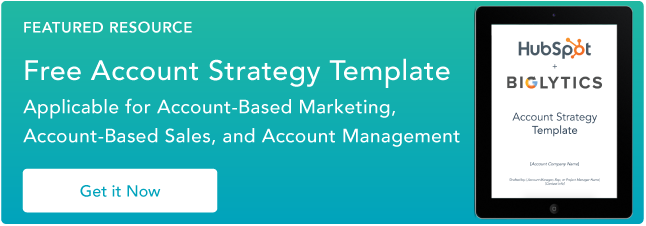This hyper-personalized approach is typically too high-touch for B2C products, but it can be ideal for organizations selling to enterprises. Read on for a deep dive into account-based sales.
- What Is Account-Based Selling?
- Who Should Use Account-Based Selling?
- How to Define Your Ideal Customer Profile
- How to Define Your Buyer Personas
- How to Use Content in Account-Based Selling
- How to Build Your Target Account List
- How to Structure Your ABS Sales Team
- Key Metrics for Account-Based Selling
- How to Implement Account-Based Selling
While ABM is the most well-known term, TOPO CEO Scott Albro argues this definition is too limiting. A successful account-based approach requires cross-department coordination. Every team — Sales, Sales Development, Marketing, Customer Success, Finance, Product, Engineering, and the C-suite — must be aligned. Albro proposes we use “Account-Based Everything,” or ABE.
No matter what you call it, this approach isn’t altogether new: Enterprise salespeople have used an account-level approach for a long time. But as Engagio CEO and founder Jon Miller explains, “There are no ‘hand-offs’ in an Account-Based Everything (ABE) model. Instead, Marketing and Sales work together from the very start, and throughout the revenue cycle.”
Executives are also involved in closing these accounts — giving strategic direction, meeting with customer stakeholders, helping the account team acquire any necessary resources, and so on.
ABS maintains this account-level focus after the sale. Customer success managers deliver a custom onboarding experience, then work to develop relationships with multiple stakeholders at multiple levels (rather than leaving an account’s success to a single advocate, power user, or internal champion).
Meanwhile, account managers and marketers work hand-in-hand to identify upsell and cross-sell opportunities. The product team uses insights from customer stakeholders to plan new features and develop potential use cases.
Who should use account-based selling?
Successfully implementing an ABS model requires company-wide buy-in. Before you upend your current business model, determine whether you’re the right fit with the following five questions.
Criteria for Account-Based Sales
1) Who are our customers?
If you’re selling to SMBs, ABS is likely the wrong approach. You can’t afford to dedicate the necessary manpower and resources to every account.
The answer is less black and white if your customers are mid-market. If your average deal size is greater than $50,000, sales expert and author of The Sales Development Playbook,Trish Bertuzzi, highly recommends an account-based approach.
If you provide enterprise or complex solutions, you’re probably targeting a select number of high-value accounts already.
2) How well do we know our ideal customers?
ABS requires laser precision of target accounts. If you’re still determining product-market fit, or you don’t have enough data or existing customers to identify their common characteristics, consider holding off on ABS.
3) How many customer stakeholders are involved in our average deal?
As the number of people involved in the purchasing decision rises, so does the need for a multi-threaded, or ABS, approach. Targeting every stakeholder within the organization (as opposed to one or two) minimizes the risk the deal will stall or fall through if your contact(s) change jobs, go on leave, take a trip, get sick, and so on. It also helps you facilitate consensus: You can identify potential blockers and address their concerns before they stop the deal in its tracks.
4) How long is our average sales cycle?
Deal complexity and sales cycle are highly correlated. If your average sales cycle lasts three or more months, ABS makes sense.
5) What’s the nature of our product?
Because ABS delivers a tightly integrated experience across Sales, Marketing, and Customer Support, it’s a great fit for subscription-based products. Customers are far less likely to churn when your messaging is clear and consistent and you uphold your claims. This also provides an opportunity to upsell and/or cross-sell, making ABE an optimal approach if you offer a variety of packages, tiers, add-ons, or complementary services.
If, on the other hand, you offer a one-time purchase product, explore other possibilities before committing to ABS.
ABS or Nothing?
If you sell to a mixture of mid-market and enterprise companies, going all-in on ABS may not be the most productive approach. Your efforts will be well-suited to your larger customers but excessive for your small accounts.
Some companies have found a workaround: Tiger teams. These independent teams are dedicated to working a select group of potentially huge deals — in other words, it’s ABS on a small scale.
A mixed approach is also useful if you’re hoping to move upmarket. You can pursue more lucrative customers while refining your approach. Once you’ve gotten several logos, identified the key drivers for these accounts, crafted a successful marketing strategy, and most importantly, made your solution more robust, transition your entire sales team to an account-based model.
What's an ideal customer profile?
When you focus your time, energy, and resources on a limited number of accounts, being highly selective with those accounts is crucial. You’re putting all of your eggs in a couple of baskets — if you target the wrong company, it’ll have a noticeable impact on your revenue. Not to mention the opportunity cost: Every poor fit your team targets means you miss out on a potential great fit.
That’s why a huge component of ABS is your Ideal Customer Profile (ICP). The ICP defines your most valuable customers and prospects who are also most likely to buy.
According to TOPO senior demand generation analyst Eric Wittlake, having an ICP lets you decide whether to target an account without bringing together your entire leadership team.
"This ensures we don’t put ourselves in position of gathering in a conference room every three months to debate which companies should be on our list," he explains.
Base your ICP on the following six factors.
A Framework for Identifying Your ICP
1) Input from your team members
ABE relies on tight cross-organizational alignment: If you exclude certain departments, you’ll end up with siloed information and conflicting strategies. With that in mind, involve representatives from Sales, Customer Success, Marketing, Finance, and Sales Operations in the planning process.
Your salespeople know from direct experience which types of accounts are easiest to sell to, while those in customer success can tell you which companies require the least support and see the most success with your product.
Marketers have insight into prospects’ pain points. For example, if your most popular content offer is an ebook on improving poor morale, your customers clearly struggle with low employee engagement.
Meanwhile, your finance team has valuable information on the types of customers that generate the most revenue, how much MRR or ARR you'll need to generate, how much you can spend on marketing expenses, and more.
Finally, ask Sales Ops for conversion rate, sales cycle, and close rate data.
2) Firmographic data
Single out the characteristics of companies that are likeliest to close, including:
- Industry, market, and vertical(s)
- Number of employees
- Revenue
- Financial performance
- Type
- Market share
- Location and/or number of offices
- Historical growth
- Predicted growth
3) Internal data
Your CRM holds a wealth of information about your ideal customers. Review your closed-won accounts, most profitable accounts, least likely to churn, and so on.
4) Technographics
Customers don’t use your product in isolation: They add it to their existing tools or use it to replace a tool they’re no longer satisfied with. Identify your product’s competitive and complementary solutions to gain a more accurate picture of its optimal user.
As an example, HubSpot and Eventbrite integrate. That means a business using Eventbrite for marketing purposes would likely be a good fit for HubSpot’s products, since it wouldn’t need to change or modify its current set-up.
If a potential customer is using a competitive product, they’re clearly aware of — and concerned about — the problem or opportunity your solution speaks to. A technology monitoring tool like Datanyze lets you keep track of the products your prospects are using. Their open job descriptions are also telling: If a company is looking for experience with a certain product, you can infer they currently use that product or are transitioning soon.
5) Behavioral data and trigger events
Pinpointing the common behaviors and events your best customers exhibit is more art than science. But doing so is incredibly beneficial.
Maybe half of your highest-performing accounts launched a new product line shortly before signing up. Your ICP should include “recent product launch.”
However, not every behavioral data point is this extreme or obvious. Perhaps the majority of your best customers sent employees to your annual conference or virtual summit. One of the easiest ways to find these trends is to ask your top accounts, “What initially prompted your interest in our product?” or “Why did you take action then, rather than earlier or later?”
6) Predictive analytics
Predictive analytics can take your ICP’s accuracy and sophistication to the next level. Using data science, these tools comb through your data, note trends and commonalities (some subtle enough you may have missed them), and develop a model of your best customers. Not only can you predict your likelihood of winning new prospects, you can also learn their likely value, when to reach out, and which accounts to target next.
However, it's worth noting you don't need predictive analytics to get started with ABS. Manual research, combined with the information you currently have on best-fit prospects, is enough to compile an ICP — and from there, a target account list.
Defining Your Buyer Personas
Once you've identified which accounts you'll target, establish the key players within those accounts. The average B2B purchase now involves 6.8 stakeholders. To win the account, you'll need to connect with each one.
Review the past 50 deals you've closed that most closely reflect your new ICP. With whom did you engage? Which stakeholders tended to have the most influence? Who was the budget authority?
Now review the past 50 deals you lost. Did you usually fail to engage with a certain member of the buying committee? Were there any relationships that ultimately didn't impact the decision?
With this information, you can map out the key contacts within every account.
Suppose you're selling marketing and sales automation software. The typical buying committee might include the CMO, the Director of Sales, a sales manager, a marketer, a representative from Sales Ops, and someone from Finance.
For each buyer persona, map out their challenges, objectives, professional goals, and their involvement in the buying process. It's also good to know where they go for information and the best way to reach them (email, phone, at events, etc.).
Every stakeholder should receive content tailored to their challenges and communication preferences.
How to Use Content in Account-Based Selling
Like inbound marketing, account-based sales relies on content tailored to a specific audience. The similarities don’t end there: Both approaches use different content and offers depending on the stage of the sales process.
SDRs and marketers should collaborate to find the most effective content for different accounts and buyer personas.
Prospecting
Low-effort:
- Email: Use personalized emails to connect with stakeholders within your target accounts.
- Voicemail: Includes a quick tip and/or “warm up” your recipient for your email to deliver value at every touch.
- Mail: Package and letters can help you grab someone’s attention — provided you’re creative. Print a case study for a similar organization and incorporate the contact’s name, their company logo and name, and other relevant details so it’s clearly meant for them. For example, the cover might read, “[Prospect name], is [prospect’s company] struggling with [challenge]? Here’s how [similar company] achieved [results].”
- Blog posts, infographics, and short videos: Quickly engage with a contact with “snackable” content.
- Social media: Engage with customer stakeholders on LinkedIn, Twitter, Facebook, and other social platforms.
- Report: Position your company as a thought leader by releasing relevant data and research.
Medium-effort:
- Custom report: Create a report outlining unique suggestions, vulnerabilities, and/or strategies for your target company.
- Webinars: Target employees from a single company. You might host a webinar called, “How [prospect’s company] can [capitalize on opportunity]” and limit registration to their employees.
- Workshop: Host a workshop on a topic some of your stakeholders are interested in. For example, if there’s typically an IT supervisor on your account’s buying committee, invite IT supervisors from your current and potential customers to attend a complimentary session on data integrity best practices.
- Business case: Demonstrate the potential ROI of your product using information you gathered during discovery and from independent research.
High-effort:
- Company workshop: Narrow your strategy even more, and offer to run an on-site workshop or series of workshops specifically for one of your accounts.
- Trials: Letting prospects “try before they buy” can be mutually beneficial. Prospects feel safer about the purchase when they’ve experimented with the product and verified the end users will actually adopt it. In addition, they’re likelier to pull the trigger once they’ve invested time and effort into trialing it.
After the Sale
Customer satisfaction is a core element of ABS. If your customers aren’t happy, they won’t upgrade, buy more, or buy again — nor will they connect you with stakeholders within your other target accounts.
With that in mind, it’s important to continue delivering valuable content and guidance after the agreement is signed.
- Executive check-ins: TOPO suggests holding quarterly meetings between executives from the buyer and seller to discuss what’s going well, areas for improvement, and potential roadblocks. These check-ins also let the buyer explore potential upsell, cross-sell, and referral opportunities and demo upcoming product releases relevant to the seller’s needs.
- Training sessions: Help clients maximize your product’s value by teaching them how to use certain features or capabilities, avoid common issues, prepare for specific situations, and more.
- User events: Generate enthusiasm for your product and brand with events bringing multiple customers together.
How to Create a Target Account List
Now that you've formulated the types of accounts you'll target, the people within those accounts you'll connect with, and the various types of content you'll use to engage them, you're ready to build an actual account list.
ABS experts recommend creating a target account list with different tiers. Your team should allocate a different level of resources, personalization, and attention to each, with the smallest tier receiving the most and the largest tier receiving the least.
The first tier typically consists of 20 to 50 accounts. The accounts in this tier receive deep research and one-to-one customized outreach. Sales, Sales Development, Marketing, and executive leadership are involved in bringing in this business.
The second tier includes approximately 200 accounts. These receive personalization based on their industry and persona. SDRs engage with them via phone, email, and social, while the marketing team uses advertising, and events. These multi-touch campaigns span several weeks.
Make sure your Sales Development and Sales teams help you select target accounts. They'll play an instrumental role in converting these prospects to customers — if they don't believe an account is a good fit, they're unlikely to truly pursue it.
How to Structure Your Sales Team for Account-Based Sales
True to form, the standard ABS team includes members from departments that are typically separate: Sales, Marketing, Customer Support, and Solutions/Implementation.
Here are the primary roles:
- Account executive: Runs internal meetings, shapes the account strategy, acts as the primary liaison with the prospect and works to become their trusted advisor
- Sales development representatives: Research the account and update the CRM, create personalized messaging and content designed to build relationships with multiple customer stakeholders
- Marketer: Develops the overall playbook and messaging strategy, coordinates marketing campaigns, tracks success of program
- Support representative: Keeps the team up-to-date on the account and surfaces issues when they arise
- Industry marketer (optional): If a company sells to multiple industries, a subject matter expert educates the overall team and makes sure its messaging and strategy are relevant, accurate, and technically sound
- Product manager (optional): Keeps the team and customer informed on future product updates and changes
Some sales executives recommend a 1:1 ratio for SDRs, AEs, and CSMs. However, the average ratio is one SDR to 2.5 AEs. Larger companies tend to have more AEs for every one SDR, according to a recent TOPO report.
Which ratio should you choose? It depends on your organization’s maturity, size, and objectives. If you want to maximize average account value, have several AEs share one SDR. If you want to acquire customers, assign several SDRs to one AE.
Key Metrics for Account-Based Selling
At the top of the funnel, track how effectively SDRS are engaging prospects. Are they reducing the ratio of outreach attempts to meaningful conversation and from meaningful conversation to meeting?
To gauge your overall ABS success, Wittlake advises tracking average contract value (ACV) or deal size and lifetime value (LTV). TOPO reports some organizations see a 75% increase in ACV and 150% in LTV.
Because you're dedicating greater resources to individual amounts, your customer acquisition cost (CAC) will rise. Compare your previous LTV:CAC ratio to the current one. If your former ratio was 2:1 and now it's 4:1, you're on the right track. The rise in time, energy, and resources to acquire a new account is more than justified by the growth in profits.
Moving upmarket usually leads to an extended sales process, since there's a greater number of decision-makers, internal hoops to jump through, and other factors complicating the deal. But although you might expect your sales cycle to get longer with ABS, Wittlake says this isn't necessarily the case.
"Yes, bigger deals with more complicated buying environments take longer," he says, "but since an account-based approach lets you prioritize on fewer accounts and bring your resources to bear on them, deal times usually shrink (all things held equal)."
How to Implement ABS
One of the biggest obstacles facing ABS practitioners is a lack of understanding around the transition, Wittlake says.
He explains, "People know the value of the change — but they struggle to do it."
If you're currently using a high-volume, high-velocity approach, switching to ABS out of the blue is risky. Your lead flow might dry up before you've begun seeing success with the new approach.
To avoid this scenario, Wittlake recommends shifting in stages. After you've defined your ICP and identified the accounts that fit that profile, put 30% of your organization into tiger teams.
"Once they've started seeing some traction, go to 50% of your team using ABS," Wittlake says. "Then go to 75%, and finally 100%."
How long should the transition take? TOPO says it varies widely, but most companies find themselves vastly outperforming their sales plan, forecast, and objectives in 12 to 24 months.
Organizations that see earlier success typically have watertight alignment between Marketing and Sales.
Here's a high-level view of the steps you'd take to implement ABS:
Account-Based Selling Plan
- Review best customers
- Define ICP
- Define buyer personas
- Develop a content strategy
- Create target account list
- Segment these accounts into tiers
- Allocate one-third of current sales development team to pursuing target accounts
- Decide which metrics to track
- Shift the next 20% of team to ABS
- Analyze content strategy to decide where to double down and where to course-correct
- Shift the next 25% of team to ABS
- Review key metrics
- Shift last 15% of team to ABS
Editor's note: This post was originally published in July 2019 and has been updated for comprehensiveness.
Account Based Sales





.jpg)